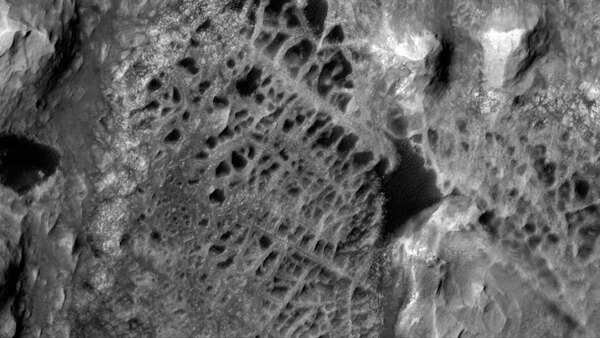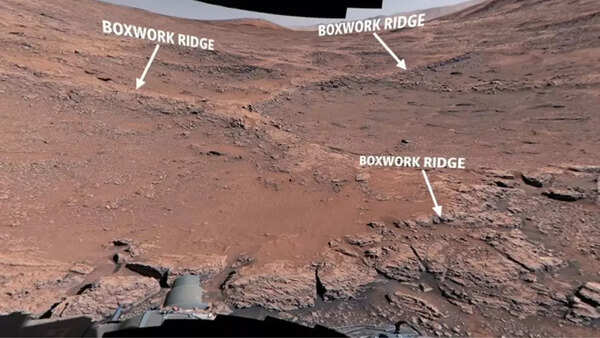NASA's Curiosity rover has transmitted the first close-up images of unusual, spiderweb-like rock formations on the surface of Mars. These intriguing structures are providing valuable insights into the Red Planet's ancient, aquatic past.
The intricate, zig-zagging formations, referred to as "boxwork," were discovered on the slopes of Mount Sharp within Gale Crater, where the Curiosity rover has been actively exploring since 2012. These complex, mineral-rich ridges are believed to have been created by ancient groundwater activity and, when viewed from above, bear a striking resemblance to spiderwebs. Scientists are optimistic that these formations may unlock crucial information regarding Mars' potential to sustain microbial life in its distant past.

Despite their descriptive nickname, these spiderweb-like structures are not the work of Martian insects. Instead, they are geological features known as boxwork. This pattern of intersecting mineral ridges forms when groundwater permeates cracks within rocks, depositing minerals. Over extended periods, wind erosion gradually removes the surrounding, softer rock, ultimately revealing the hardened, web-like framework beneath.
While boxwork formations have been observed from orbit, this marks the first instance of their close-up examination on Mars. The Curiosity rover arrived at this location in early June 2025, following months of navigating the terrain of Mount Sharp. On June 23, NASA released both the images and a 3D interactive video of the formations, highlighting them as a top scientific priority because of their unique structure and enigmatic location.

Analysis of the surrounding rocks has revealed veins of calcium sulfate, a salty mineral residue commonly left by groundwater. These findings suggest that the area was once abundant with liquid water, and the subsurface environment may have been warm and salty. These conditions potentially created an environment hospitable to microbial life, akin to certain regions on early Earth.
It is essential to distinguish the newly imaged boxwork formations from the "spiders on Mars," which are dark, radial patterns caused by carbon dioxide ice erupting from beneath the surface. Unlike these seasonal features, boxwork is permanent and mineral-based, formed through geological processes rather than atmospheric ones.
Scientists hypothesize that these formations could play a pivotal role in resolving the question of whether Mars once supported life. The mineral composition, the protection offered by underground conditions, and the evidence of flowing water all indicate an environment that could have supported microbial organisms. As Curiosity mission scientist Kirsten Siebach noted, "Early Earth microbes could have survived in a similar environment."
The Curiosity rover will continue its investigation of this boxwork region on Mount Sharp, collecting samples and conducting thorough chemical analyses. Researchers are hopeful that these unique structures will not only shed light on Mars' climatic history but also guide future missions in the ongoing quest to find signs of life beneath the Martian surface.
Newer articles
 Chess Star Praggnanandhaa Weighs In on Carlsen's Frustration After Loss to Gukesh
Chess Star Praggnanandhaa Weighs In on Carlsen's Frustration After Loss to Gukesh
 Samsung Galaxy A35 5G and A55 5G: Official Pricing and Availability Announced
Samsung Galaxy A35 5G and A55 5G: Official Pricing and Availability Announced
 India's Fielding Woes Blamed for First Test Defeat Against England: Former Selector Voices Concerns
India's Fielding Woes Blamed for First Test Defeat Against England: Former Selector Voices Concerns
 Headline: Viral Optical Illusion: Can You Find All the Hidden Animals? Only 1% Succeed
Headline: Viral Optical Illusion: Can You Find All the Hidden Animals? Only 1% Succeed
 Shadman Stands By Bangladesh Batters After Day 1 Struggles Against Sri Lanka
Shadman Stands By Bangladesh Batters After Day 1 Struggles Against Sri Lanka
 Norris Claims Thrilling Austrian GP Victory After Intense Duel with McLaren Teammate Piastri
Norris Claims Thrilling Austrian GP Victory After Intense Duel with McLaren Teammate Piastri
 Jake Paul's Title Dreams: Analyzing Championship Prospects and Potential Opponents
Jake Paul's Title Dreams: Analyzing Championship Prospects and Potential Opponents
 Gavaskar Urges India to Unleash Kuldeep Yadav in Second Test Amid Bumrah Fitness Concerns
Gavaskar Urges India to Unleash Kuldeep Yadav in Second Test Amid Bumrah Fitness Concerns
 iQoo Z9 Turbo Leaks: Snapdragon 8s Gen 3, 1.5K Display, and Massive Battery Detailed
iQoo Z9 Turbo Leaks: Snapdragon 8s Gen 3, 1.5K Display, and Massive Battery Detailed
 Mirabai Chanu Reveals Relentless Dedication: Training and Weight Always Top of Mind, Even During Family Time
Mirabai Chanu Reveals Relentless Dedication: Training and Weight Always Top of Mind, Even During Family Time